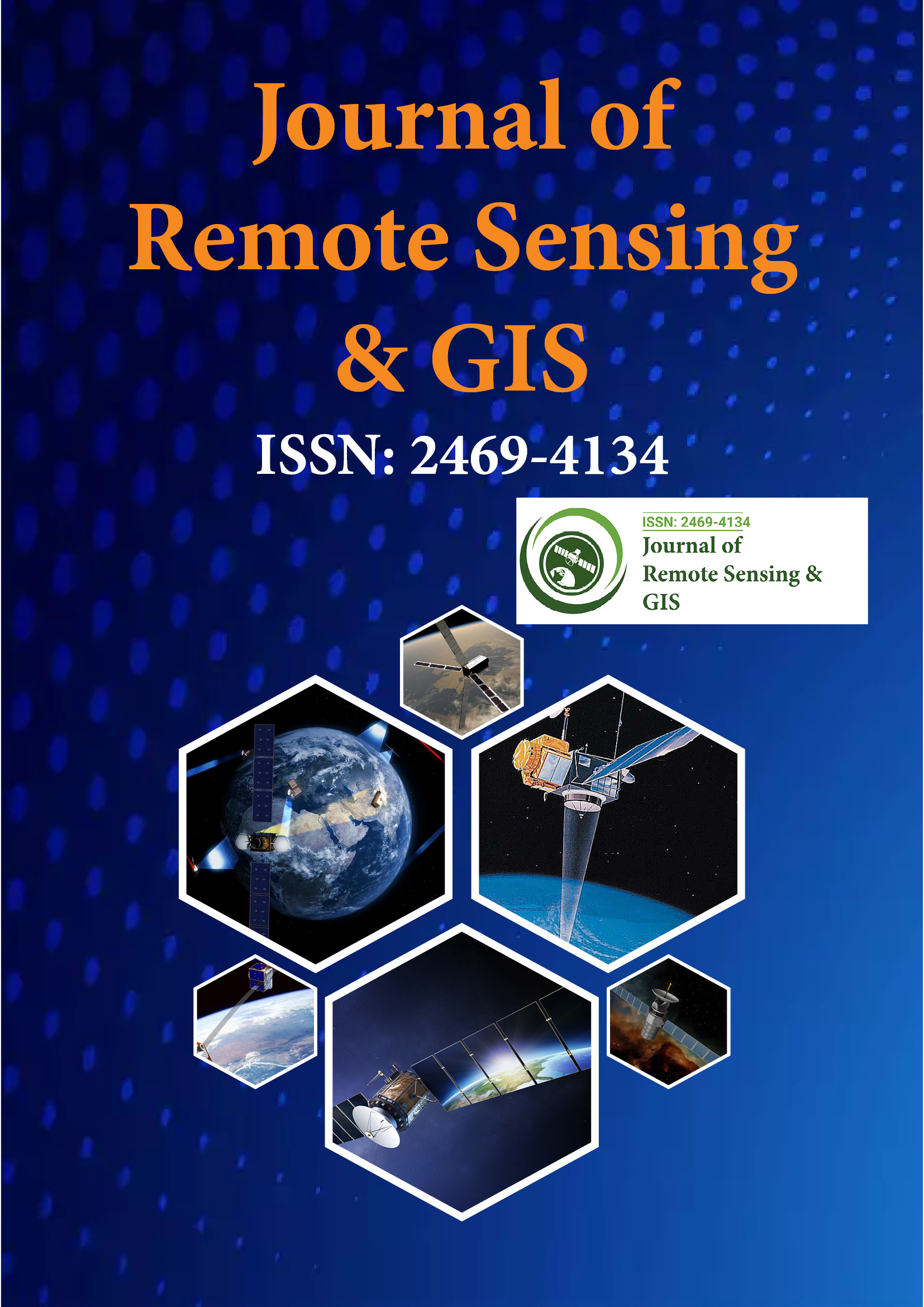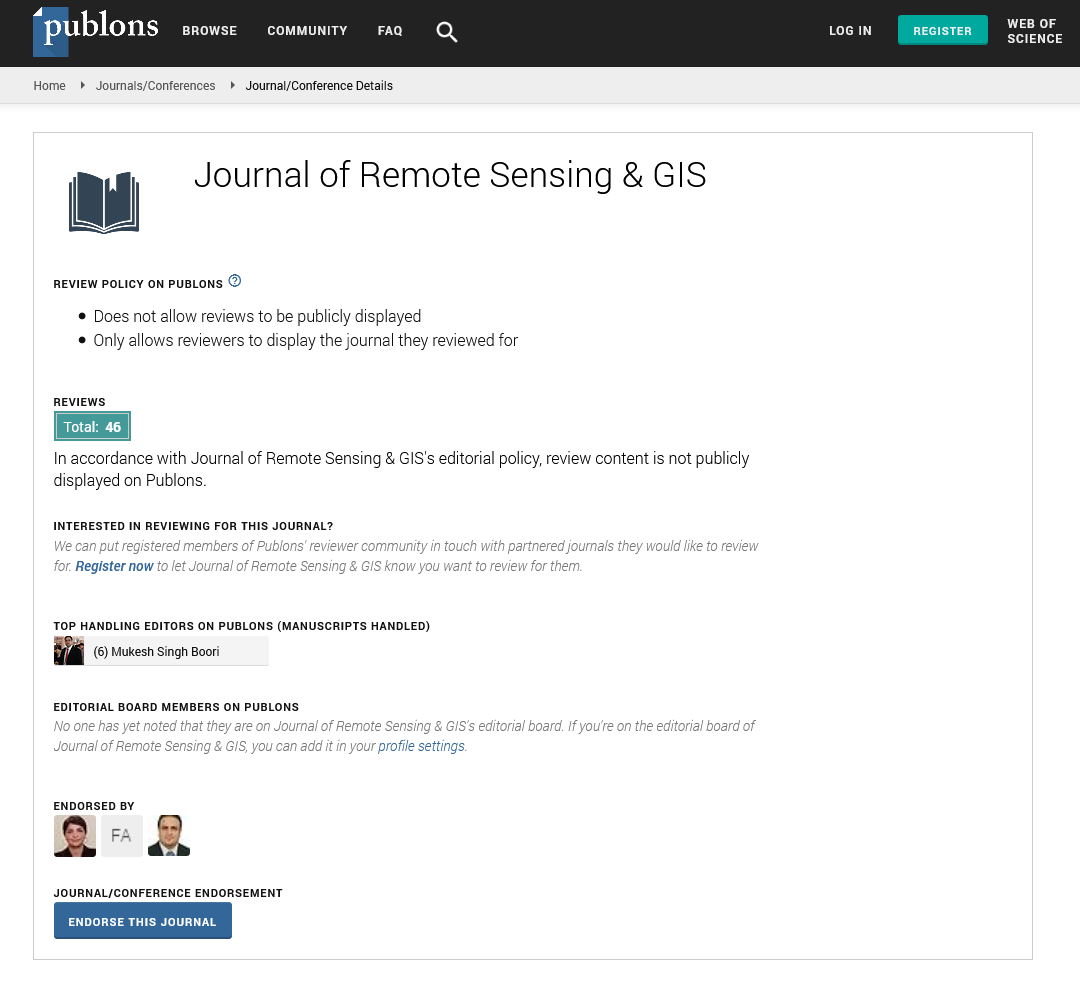Indexed In
- Open J Gate
- RefSeek
- Hamdard University
- EBSCO A-Z
- OCLC- WorldCat
- Publons
- International Scientific Indexing
- Euro Pub
- Google Scholar
Useful Links
Share This Page
Journal Flyer

Open Access Journals
- Agri and Aquaculture
- Biochemistry
- Bioinformatics & Systems Biology
- Business & Management
- Chemistry
- Clinical Sciences
- Engineering
- Food & Nutrition
- General Science
- Genetics & Molecular Biology
- Immunology & Microbiology
- Medical Sciences
- Neuroscience & Psychology
- Nursing & Health Care
- Pharmaceutical Sciences
Perspective - (2024) Volume 13, Issue 4
Disaster Mitigation and Resource Optimization in Water Management through Remote Sensing Technology
Gracie Williams*Received: 25-Nov-2024, Manuscript No. JGRS-24-28062; Editor assigned: 27-Nov-2024, Pre QC No. JGRS-24-28062 (PQ); Reviewed: 12-Dec-2024, QC No. JGRS-24-28062; Revised: 20-Dec-2024, Manuscript No. JGRS-24-28062 (R); Published: 27-Dec-2024, DOI: 10.35248/2469-4134.24.13.362
Description
Effective water resources management is essential for ensuring sustainable development, especially in the face of increasing demands and climatic variability. Remote sensing technology offers an unparalleled ability to monitor, analyse and manage water resources by providing accurate and timely spatial data across large areas. Understanding the dynamics of hydrological systems is fundamental for water resource management. Remote sensing enables the observation and measurement of key hydrological parameters such as precipitation, surface water extent, groundwater levels and snow cover. Satellite-based sensors like the Tropical Rainfall Measuring Mission (TRMM) and Global Precipitation Measurement (GPM) provide near-realtime data on rainfall distribution and intensity. This information is invaluable for water budgeting and planning purposes.
Surface water bodies, such as lakes and reservoirs, can be effectively monitored using optical and radar sensors. Optical sensors, such as those on Landsat and Sentinel satellites, capture high-resolution imagery that helps delineate water bodies, track seasonal changes and estimate water volume. Radar-based sensors like Synthetic Aperture Radar (SAR) are particularly useful in cloudy or dark conditions, enabling year-round monitoring of surface water dynamics.
Groundwater monitoring has also benefited from remote sensing advancements. The Gravity Recovery and Climate Experiment (GRACE) satellite mission provides data on changes in Earth's gravity field, which can be linked to groundwater storage variations. This technology is particularly beneficial in regions with limited access to on-ground observation networks.
Water quality assessment
Maintaining water quality is a key aspect of resource management. Remote sensing technology offers a practical approach to monitor and assess water quality parameters such as turbidity, chlorophyll concentration and surface temperature. Multispectral sensors on satellites like Sentinel-2 and MODIS (Moderate Resolution Imaging Spectroradiometer) capture data that can be used to derive water quality indices. For example, changes in surface reflectance can indicate the presence of suspended sediments or algal blooms, which are critical indicators of water quality. Thermal sensors are used to measure surface water temperature, providing insights into thermal pollution and its impact on aquatic ecosystems. These methods enable authorities to detect pollution sources, assess the extent of contamination and implement timely remedial measures.
Irrigation planning and management
Agricultural activities rely heavily on effective water management and remote sensing plays a significant role in optimizing irrigation practices. By analyzing satellite imagery, it is possible to estimate evapotranspiration, soil moisture content and crop water requirements. Tools like the MODIS-based Global Evapotranspiration Model (MOD16) provide large-scale data on water consumption by vegetation.
Remote sensing aids in identifying water-stressed areas, estimating irrigation efficiency and planning water allocation. High-resolution images from satellites such as Sentinel-2 and Worldview allow for detailed mapping of croplands, enabling better monitoring of crop health and water use. Additionally, remote sensing data can be integrated with Geographic Information Systems (GIS) to develop irrigation management systems that ensure equitable water distribution and minimize wastage.
Disaster management and mitigation
Water-related disasters, including floods and droughts, pose significant challenges to water resource management. Remote sensing is an indispensable tool for disaster preparedness, monitoring and mitigation. During floods, radar-based sensors like Sentinel-1 provide accurate and timely information on inundation extents, even under adverse weather conditions. This data supports evacuation planning and resource allocation.
Drought monitoring is facilitated by remote sensing through the use of vegetation indices, soil moisture data and precipitation analysis. The Normalized Difference Vegetation Index (NDVI) and Enhanced Vegetation Index (EVI) derived from satellite imagery help identify areas experiencing water stress. Integrating these data with precipitation and temperature records allows for comprehensive drought assessment and early warning systems.
Integrated water resources management
Remote sensing also contributes to water resources management by enabling integrated assessments. By combining data from multiple sensors and platforms, it is possible to develop models that address the interconnectivity of surface water, groundwater and atmospheric water. For example, hydrological models incorporating remote sensing data are used to simulate water flows, predict future water availability and assess the impacts of land-use changes.
Unmanned Aerial Vehicles (UAVs) equipped with advanced sensors are increasingly being used for localized water resource studies. These systems provide high-resolution imagery and realtime data, complementing satellite-based observations. UAVs are particularly useful for monitoring small water bodies, assessing irrigation infrastructure and conducting post-disaster surveys.
Conclusion
Remote sensing technology has transformed the field of water resources management by providing comprehensive and timely data. Its applications span hydrological monitoring, water quality assessment, irrigation planning and disaster management, contributing significantly to sustainable water use. While challenges remain, ongoing innovations and interdisciplinary collaboration hold the potential to unlock new possibilities in managing this essential resource.
Citation: Williams G (2024). Disaster Mitigation and Resource Optimization in Water Management through Remote Sensing Technology. J Remote Sens GIS. 13:362.
Copyright: © 2024 Williams G. This is an open-access article distributed under the terms of the Creative Commons Attribution License, which permits unrestricted use, distribution and reproduction in any medium, provided the original author and source are credited.

